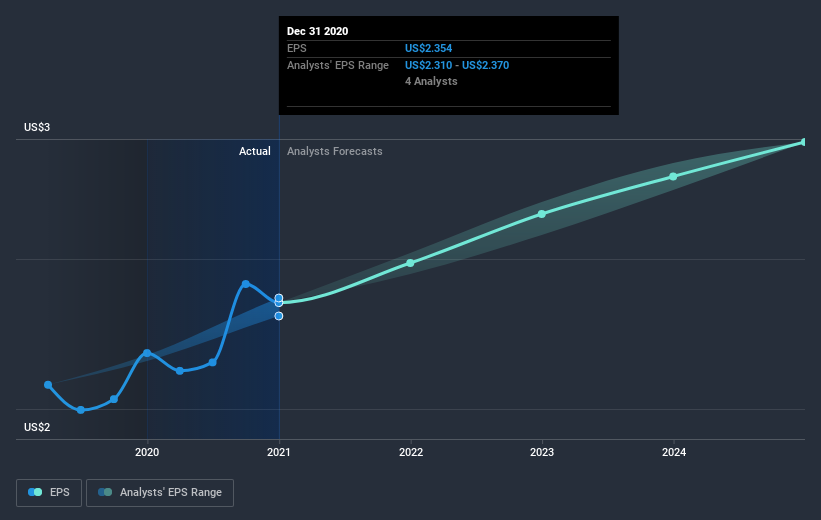Otter Tail (NASDAQ:OTTR) Has Compensated Shareholders With A Respectable 90% Return On Their Investment
The main point of investing for the long term is to make money. Furthermore, you'd generally like to see the share price rise faster than the market But Otter Tail Corporation (NASDAQ:OTTR) has fallen short of that second goal, with a share price rise of 62% over five years, which is below the market return. Some buyers are laughing, though, with an increase of 28% in the last year.
View our latest analysis for Otter Tail
In his essay The Superinvestors of Graham-and-Doddsville Warren Buffett described how share prices do not always rationally reflect the value of a business. By comparing earnings per share (EPS) and share price changes over time, we can get a feel for how investor attitudes to a company have morphed over time.
During five years of share price growth, Otter Tail achieved compound earnings per share (EPS) growth of 8.5% per year. So the EPS growth rate is rather close to the annualized share price gain of 10% per year. This indicates that investor sentiment towards the company has not changed a great deal. Rather, the share price has approximately tracked EPS growth.
The graphic below depicts how EPS has changed over time (unveil the exact values by clicking on the image).
It might be well worthwhile taking a look at our free report on Otter Tail's earnings, revenue and cash flow.
What About Dividends?
When looking at investment returns, it is important to consider the difference between total shareholder return (TSR) and share price return. The TSR is a return calculation that accounts for the value of cash dividends (assuming that any dividend received was reinvested) and the calculated value of any discounted capital raisings and spin-offs. Arguably, the TSR gives a more comprehensive picture of the return generated by a stock. As it happens, Otter Tail's TSR for the last 5 years was 90%, which exceeds the share price return mentioned earlier. And there's no prize for guessing that the dividend payments largely explain the divergence!
A Different Perspective
Otter Tail shareholders are up 33% for the year (even including dividends). But that was short of the market average. The silver lining is that the gain was actually better than the average annual return of 14% per year over five year. This could indicate that the company is winning over new investors, as it pursues its strategy. While it is well worth considering the different impacts that market conditions can have on the share price, there are other factors that are even more important. Consider for instance, the ever-present spectre of investment risk. We've identified 2 warning signs with Otter Tail , and understanding them should be part of your investment process.
But note: Otter Tail may not be the best stock to buy. So take a peek at this free list of interesting companies with past earnings growth (and further growth forecast).
Please note, the market returns quoted in this article reflect the market weighted average returns of stocks that currently trade on US exchanges.
This article by Simply Wall St is general in nature. It does not constitute a recommendation to buy or sell any stock, and does not take account of your objectives, or your financial situation. We aim to bring you long-term focused analysis driven by fundamental data. Note that our analysis may not factor in the latest price-sensitive company announcements or qualitative material. Simply Wall St has no position in any stocks mentioned.
Have feedback on this article? Concerned about the content? Get in touch with us directly. Alternatively, email editorial-team (at) simplywallst.com.

